

13 Of The Best Mourne Mountain Walks
By Author James March
Posted on Last updated: September 21, 2022

There are some mighty Mourne Mountain walks and hikes.
County Down’s famous mountain range boast some of Ireland’s most epic views and there are a ton of great walks to get stuck into in this dramatic landscape.
From tough aul slogs, like Slieve Donard, to slightly handier rambles, like Slieve Doan, there’s plenty of trails to choose from, as you’ll discover below!
Table of Contents
Our favourite Mourne Mountain walks
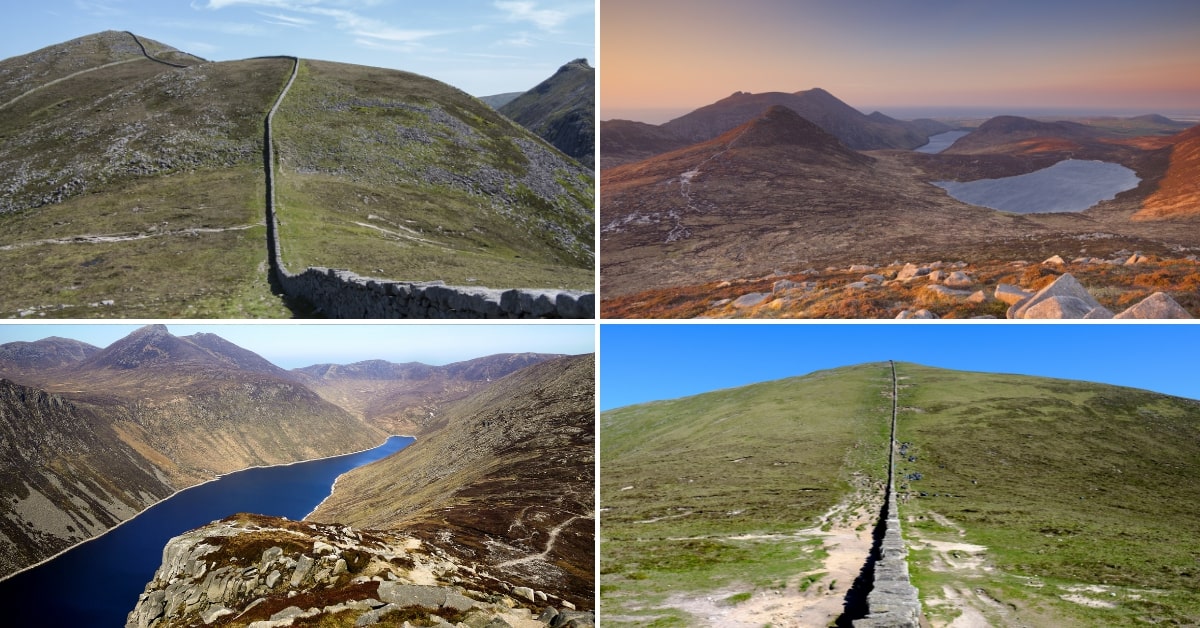
Photos via Shutterstock
The first section of the guide is packed with our favourite Mourne Mountain walks – these are rambles one or more of the team have done and loved.
Below, you’ll find Northern Ireland’s highest mountain, outstanding views and trails that’ll imprint themselves upon your mind forever more!
1. Slieve Donard (via Glen River)
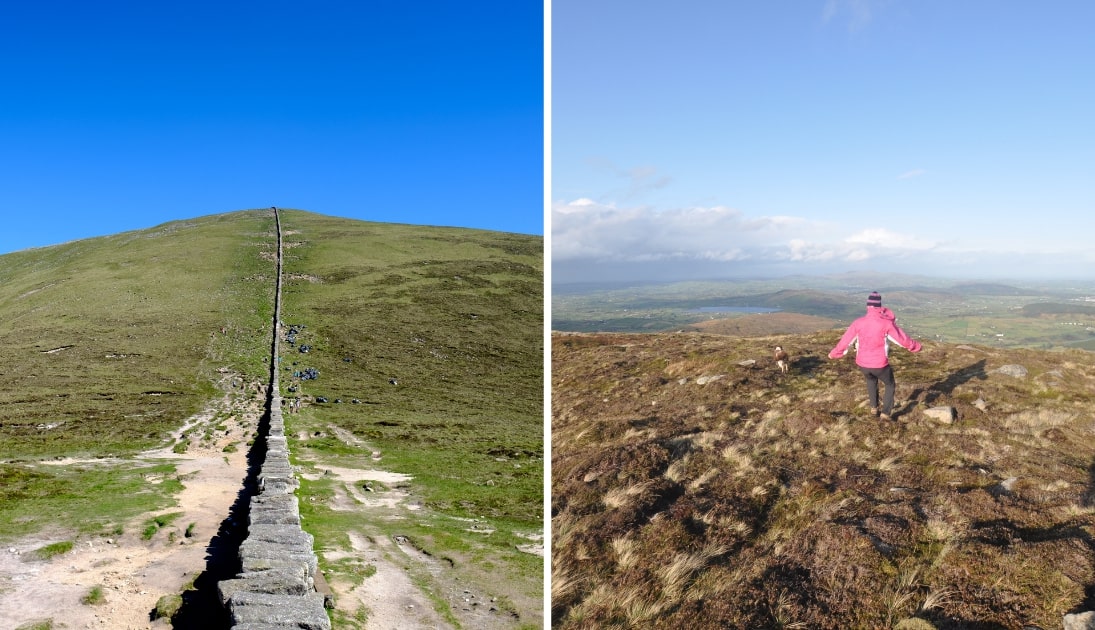
The mightiest Mourne of them all is Slieve Donard which reaches a gaudy height of 850m (2789ft), making it the tallest mountain in Northern Ireland.
We recommend the trail to the summit that goes via the Glen River, and make sure to pack a pair of sturdy walking boots and a decent supply of food and water.
It should take between 4-5 hours to complete the linear route of around 4.6km (9.2km), depending on pace and weather.
Keep in mind that, as this is one of the most popular Mourne Mountain walks, it can get busy on fine weekends.
2. Slieve Doan (via Ott Car Park)
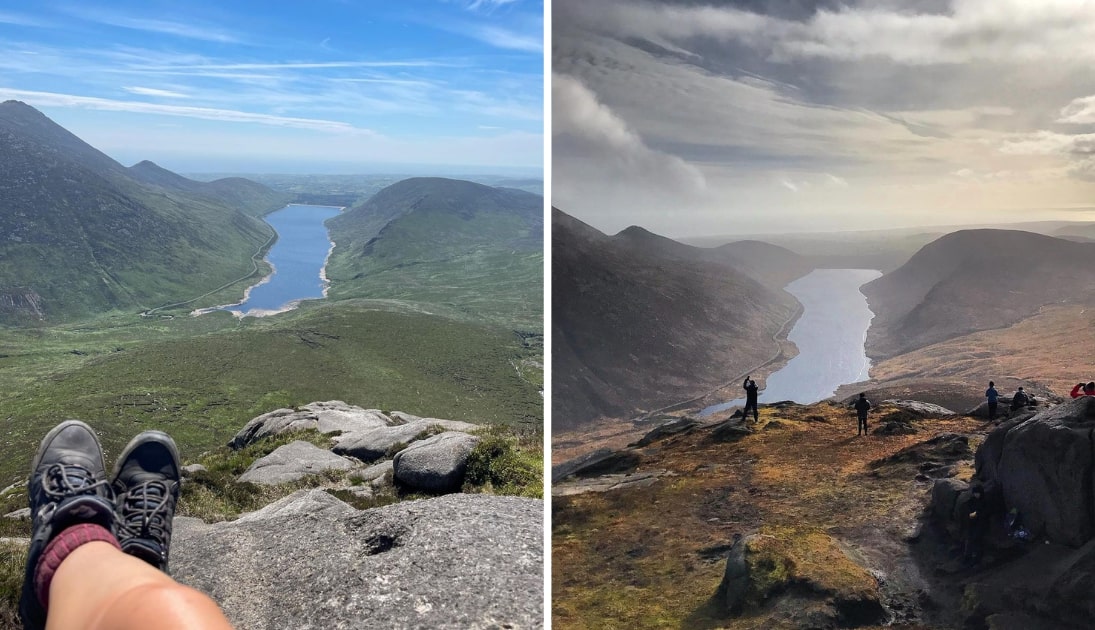
Photos with thanks to @headinthewild
Few of the Mourne Mountains walks boast views like our next hike. Despite its status as one of the smallest mountains in the High Mournes, the views from Slieve Doan are arguably as good or better than any of its taller contemporaries!
Rising to 593 metres in height, Doan is surrounded on all sides by the other Mournes but its 360-degree panoramic views make this trek more than worth it.
The length of the hike via Ott Car Park is around 8 km (5 miles) return and will take 4-5 hours to complete.
While steep and challenging in places, the route is reasonably straightforward and should suit everyone from casual walkers to seasoned hikers.
3. Slieve Bearnagh Hike (via Hare’s Gap)
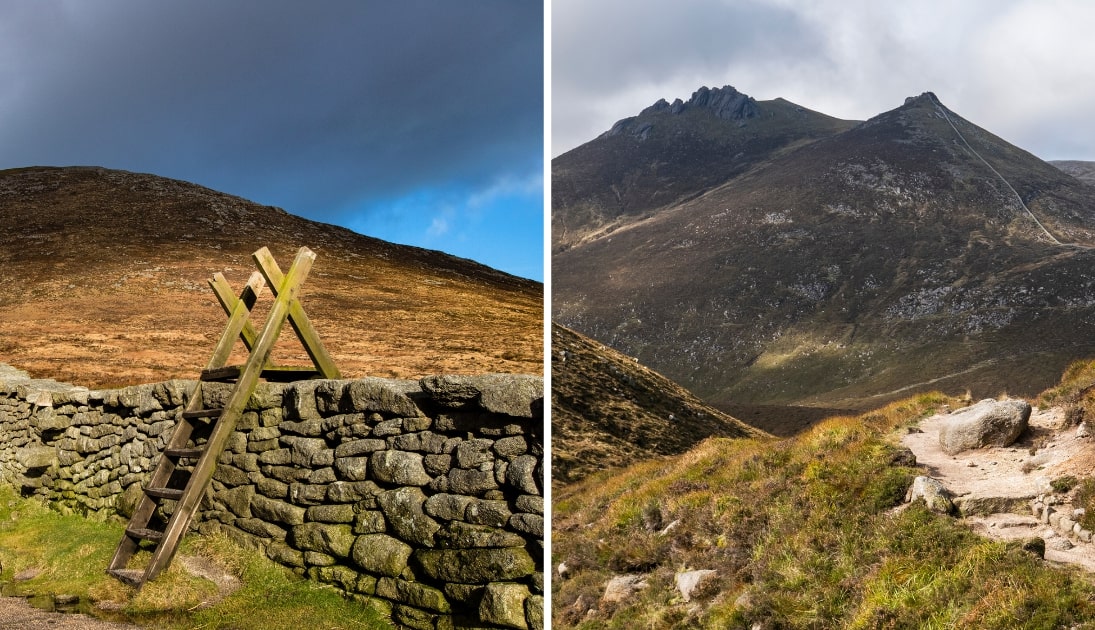
Slieve Bearnagh is one of the more distinctive mountains in the Mournes, thanks to the unique gap that makes it appear like it has two peaks!
And once you reach the top, you’ll get to see its massive tors up close too.
At just over 9km in length, the route via Hare’s Gap is a long old slog and should take between 3.5 to 4 hours to complete.
With steep pitches, rocky scrambles and ridges throughout the climb, this is one of many Mourne Mountain walks for seasoned hikers only.
4. Slieve Meelmore and Meelbeg (via Ott Car Park)
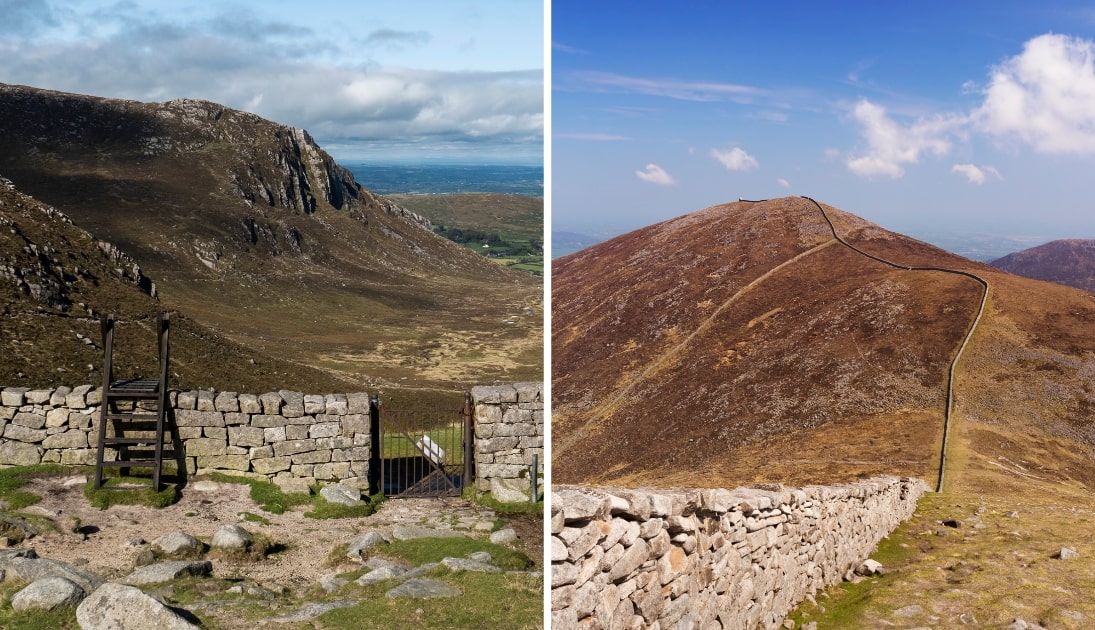
How do you feel about tackling two mountains in one walk? Not only are there some savage views to be enjoyed from Slieve Meelmore and Slieve Meelbeg , you’ll be able to say you climbed two mountains in one day!
Located in the West Mournes, the mountains are the 6th and 7th highest in the range with Meelbeg slightly taller at 702 m (2,303 ft).
Start from the Ott Car park and expect a walk of around 3.5 to 4 hours on this 11km loop trail, depending on fitness levels and stopping for snacks/photos.
More popular Mourne Mountain hikes
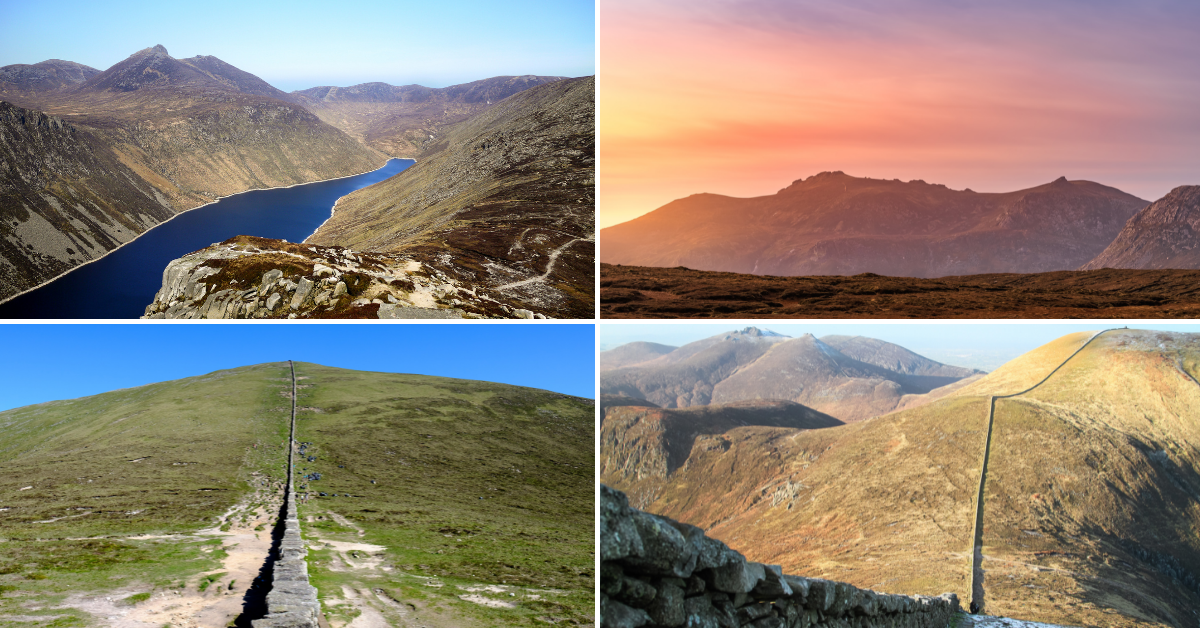
Now that we have our favourite Mourne Mountains walks out of the way, it’s time to see what other rambles the area has to offer.
Below, you’ll find everything from Binnian and the Silent Valley to some of the more overlooked Mournes walks.
1. Slieve Binnian (via Carrick Little Car Park)
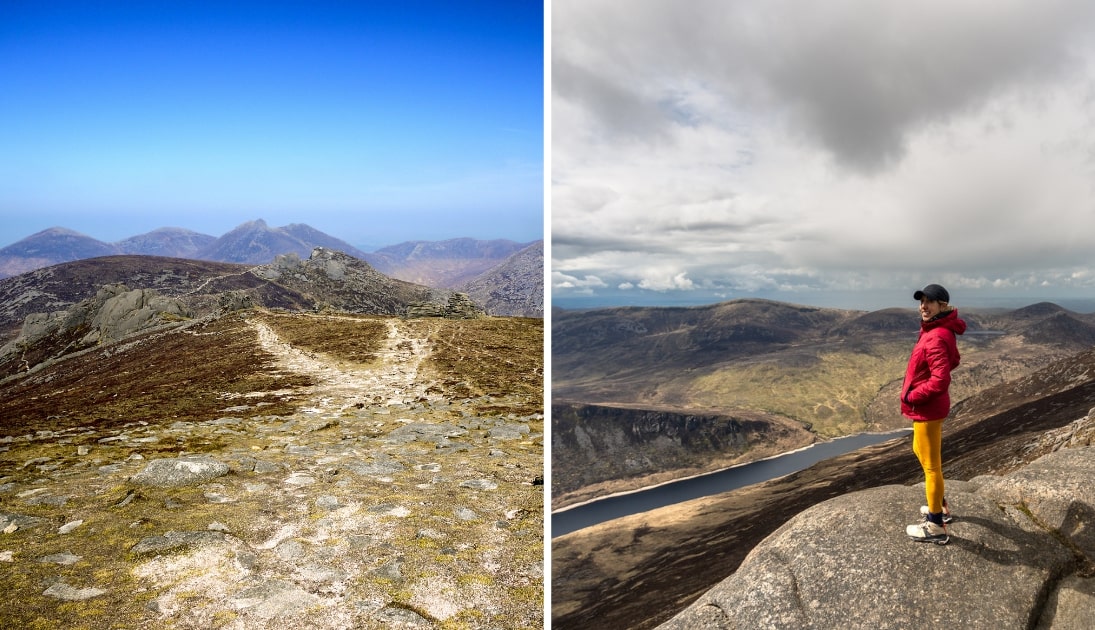
Next up is one of several looped Mourne walks. This trail will take you to the broad summit of Northern Ireland’s third-highest mountain and is a journey you’re not going to want to miss!
Taken from the Irish Sliabh Binneáin, meaning ‘mountain of the little peaks’, Slieve Binnian soars to an impressive height of 747 metres (2,451 ft).
Kicking off from the Carrick Little Car Park, it’s one of the lengthy and more strenuous Mourne Mountains walks. It clocks in at 7 miles (11.2km) and should take between 3-4 hours to complete.
Make sure to wear sturdy walking boots and don’t forget to bring snacks, water and a fully charged phone on this long walk.
2. The Hare’s Gap (via Trassey Car Park)
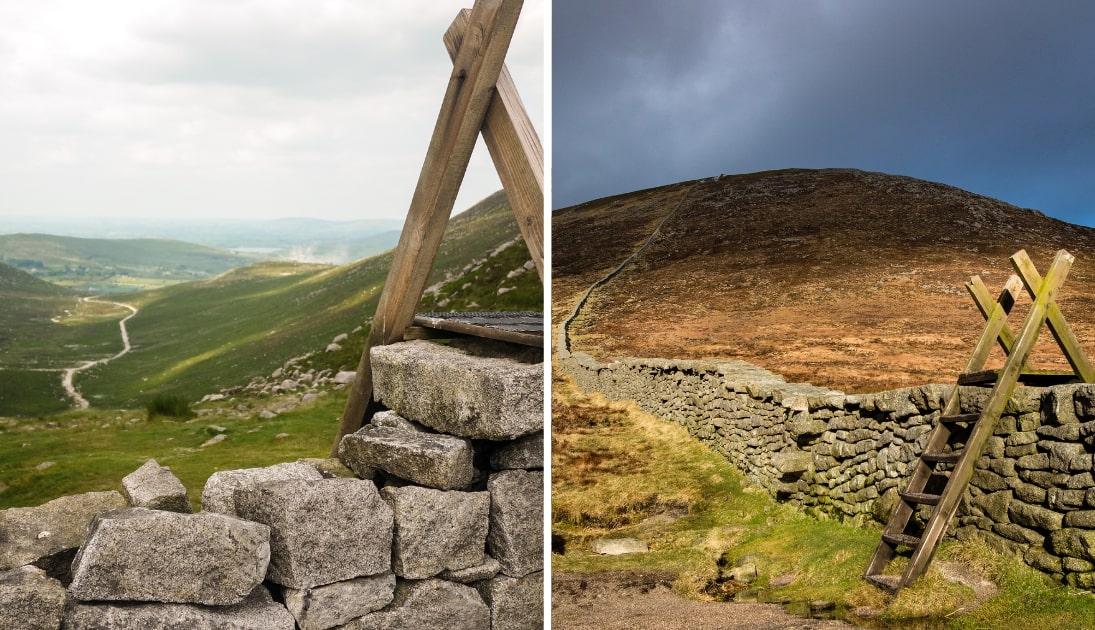
While the trek up to the Hare’s Gap doesn’t culminate in a panoramic summit vista, it will reward you with one of Ireland’s most unique views!
A reasonably straightforward ascent from the Trassey Car Park, the linear walk has a total distance there and back of 4.35 miles (7km).
Therefore it’s one of the handier Mourne Mountains walks walk and this 2.5-hour trail should be very doable for most with a decent level of fitness.
And once you’ve tackled the ramble up to the Hare’s Gap, you’ll be able to enjoy one of Ireland’s most dramatic mountain passes!
3. Cloughmore Trail (Fiddler’s Green)
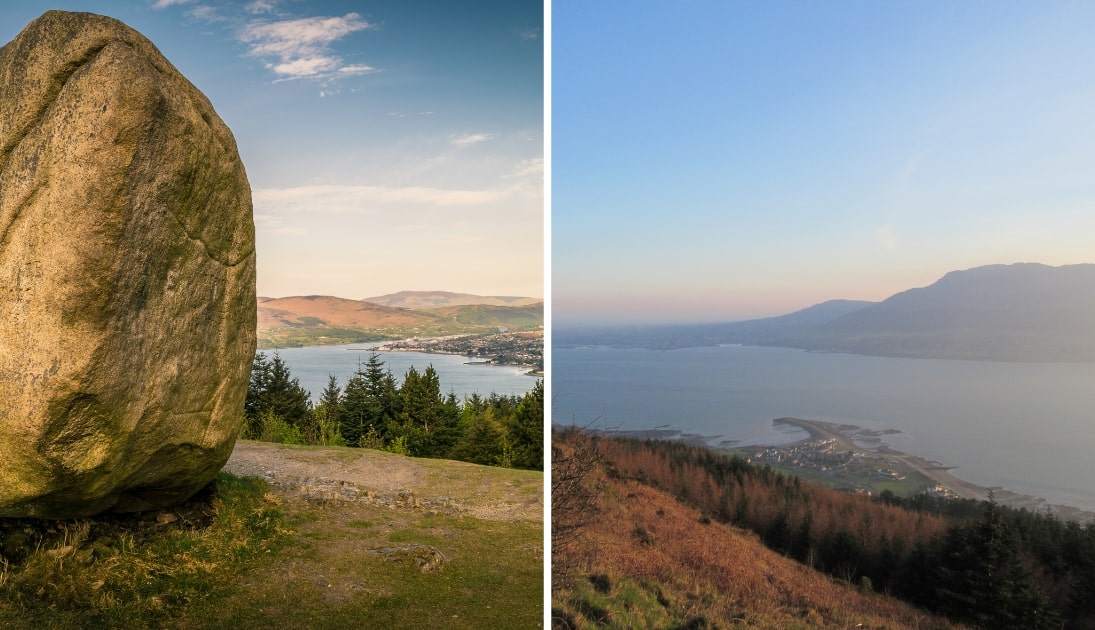
Just south of the Mournes is the gorgeous Carlingford Lough and the Cloughmore Trail is a cracking walk offers some lovely views over the grand lough.
Working your way through the equally lovely Kilbroney Park from Fiddler’s Green, this handy 2.5-mile walk follows a loop and passes by the famous Cloughmore Stone and the wonderfully-named Kodak Corner.
Enjoy some cracking vistas across the water all the way to the mighty Cooley Mountains of northeast County Louth.
Although this is one of the shorter Mournes walks, the views it treats you to are out of this world.
4. Silent Valley Reservoir (numerous trails)
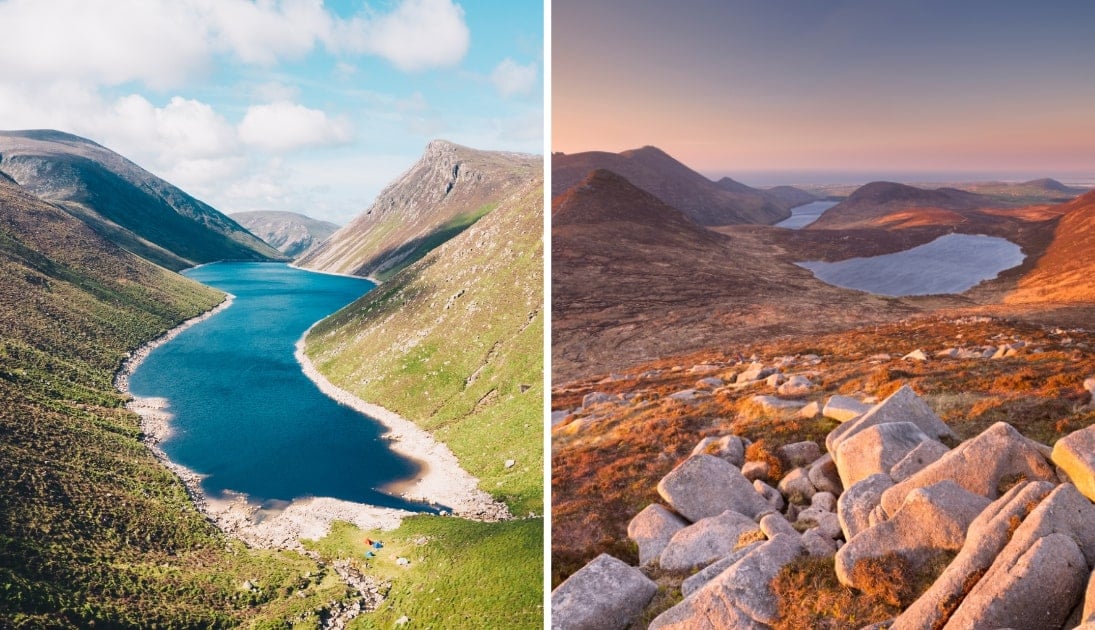
Next up is one of the more unique Mourne Mountains walks. Located just to the west of Slieve Binnian, Silent Valley Reservoir is one of the most peaceful spots in the Mourne Mountains and its reflections look gorgeous on a sunny day.
Its actual job is to supply most of the water for County Down and Belfast, but who knew it would be this pretty?!
The reservoir is also home to several cracking trails with enough variety for every level of experience.
From the handy 2.5km Heritage Trail to the more challenging 10km Mountain Trail, you can pick and choose which walk to hit and space them out over different weekends if you like.
5. The Lough Shannagh walk

The largest natural body of water in the Mourne Mountains, Lough Shannagh is another peaceful lake that’s perfect to visit any time of year.
And, of course, the best way to experience it is to take on the Lough Shannagh Walk!
Kicking off from the Banns Road Car Park, it’s an 11km circular trail that heads north and then loops around the lough before returning home.
One thing to note is that the track from the car park is in constant use by farmers herding their sheep, so keep an eye out for any woolly friends!
Related read: Check out our guide to 8 of the finest Mourne Mountain hotels to use as a base camp
Forest walks in the Mourne Mountains

The final section of our Mourne Mountains walks guide looks at rambles that take you through some of the finest forests in the land.
Below, you’ll find everywhere from Tollymore and Castlewellan to some of the more overlooked Mourne walks.
1. Tollymore Forest Park
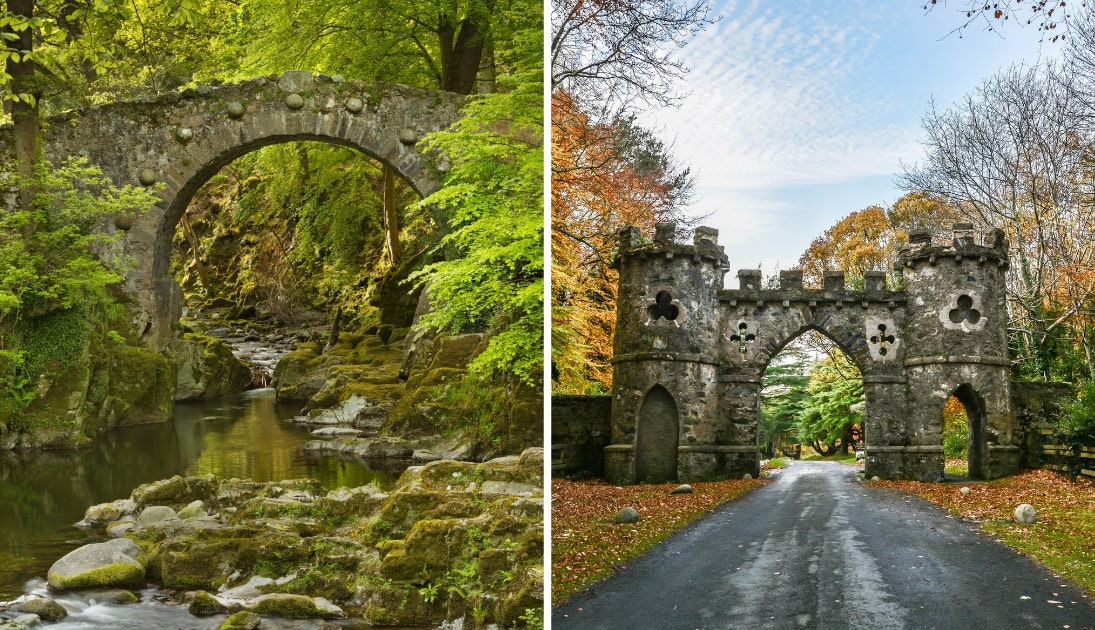
If you’d rather not put your legs through the trials and tribulations of mountain climbing, then you could always explore one of Ireland’s most enchanting parks.
Despite being located at the foot of the Mournes, Tollymore Forest Park is another world and feels like you’ve stepped into a Lord of the Rings set!
With its hanging trees and quiet trails, there’s plenty to do in the beautiful 630-hectare forest including camping, horse riding and orienteering.
There are eight superb walks to choose from, including the handy Stepstones Loop from Bryansford Road and the more challenging Horn Bridge – Waterfall Loop from Bryansford Road.
Note that, as Tollymore is home to some of the more popular Mourne walks, it can get busy at the weekend.
2. Castlewellan Forest Park
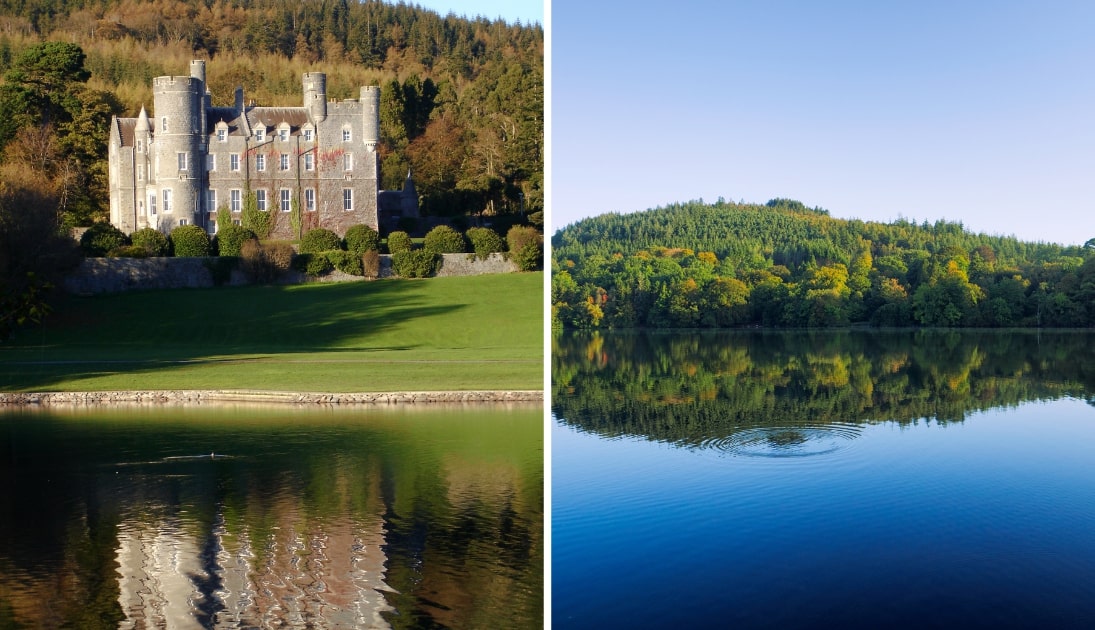
Only a few minutes’ drive north of Tollymore Forest, Castlewellan Forest Park covers 450 hectares and is an 18th-century walled demesne with mature parkland, woodland trees, forest planting, a lime tree avenue and an elaborate garden featuring terraces, fountains, ornamental gates and flower border.
All of which is to say, it’s a very pretty spot that you definitely won’t regret visiting!
Castlewellan Forest is also home to a steep walk to the summit of Slievenaslat (272 metres), but the reward is a deadly viewpoint looking towards the Mournes in all their glory.
3. Kilbroney Park
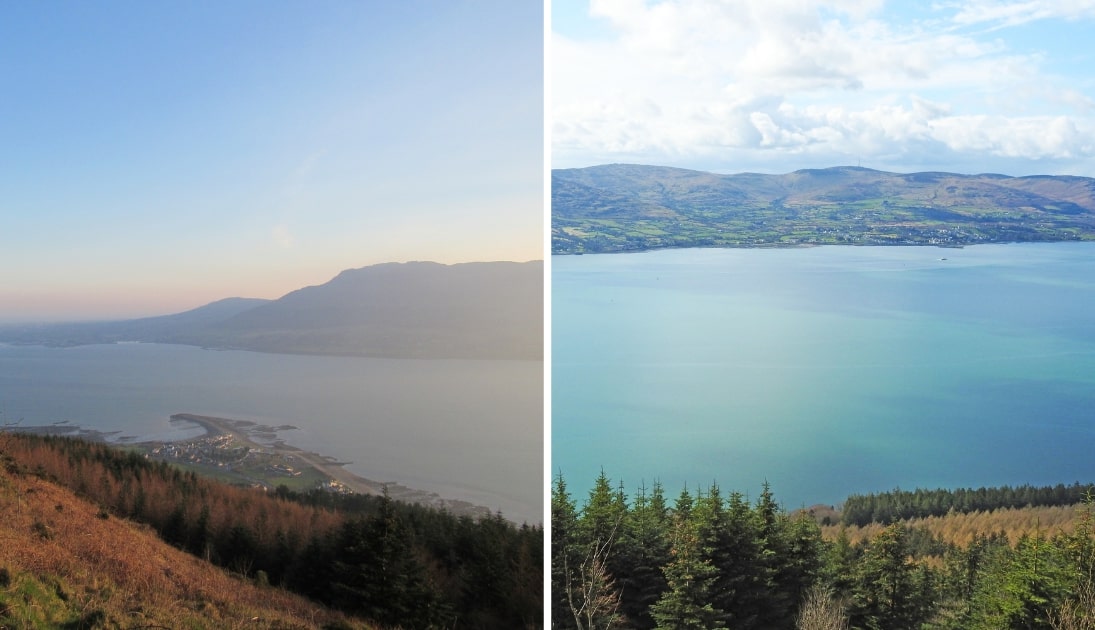
When a park contains a viewpoint known as Kodak Corner , you know it’ll be worth checking out!
Just next door to the cracking little village of Rostrevor, Kilbroney Park Forest features some gorgeous views over Carlingford Lough and towards the distant Cooley Mountains.
You’ll also be treated to riverside walks, an arboretum and the Cloughmore – a 30 ton stone that, as I mentioned earlier, has been the subject of all sorts of myth!
One good thing about Kilbroney Park is that it also features a two-mile forest drive, which is especially handy if you’re on a family visit with small children or grandparents who may find the walking trails a little tough to scale.
If you’re looking for family-friendly Mourne Mountains walks, this place is well worth considering.
4. Montalto Estate Woodland Trail
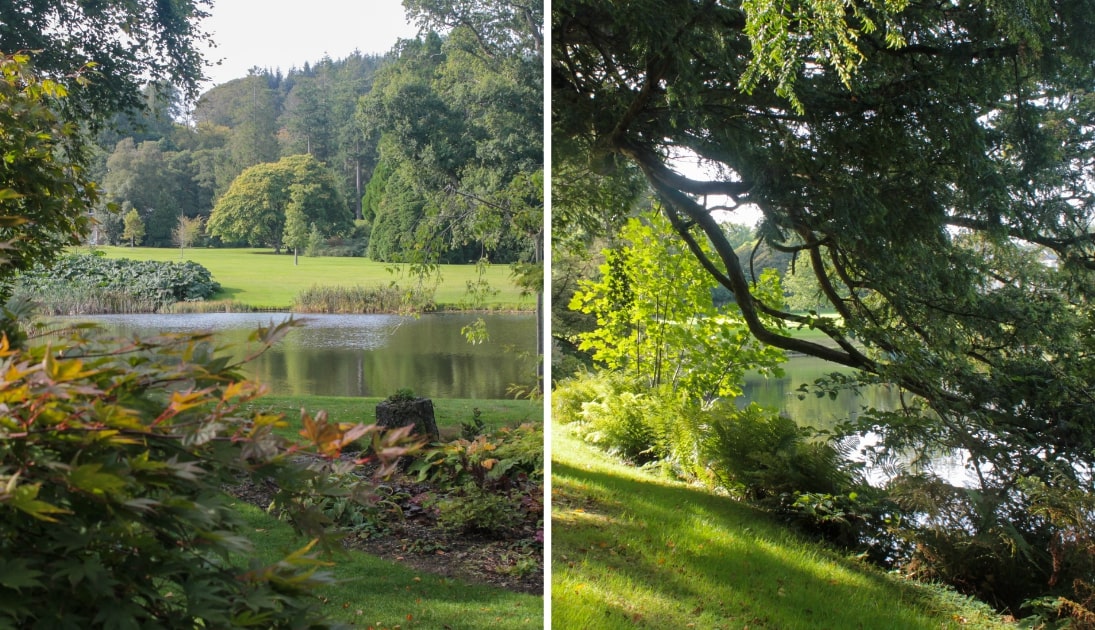
While forest trails generally won’t offer the same spectacular viewpoints as many of the Mourne walks above, they always excel when it comes to sheer variety of flora and fauna.
And in this regard, the Montalto Estate Woodland Trail is a superb walk for any fan of nature!
Noted for its many interesting and historic trees (such as birch, beech, douglas-fir, and sycamore trees), this trail north of the Mournes is a must for anyone with an interest in arboriculture and horticulture.
Also, on your way around, keep an eye out for birdlife including tree-creepers, buzzards, hawks, dipper kingfisher and – rarest of all – the great spotted woodpecker.
FAQs about the Mournes walks
We’ve had a lot of questions over the years asking about everything from ‘Which is the longest?’ to ‘Which of the Mourne walks has the best views?’.
In the section below, we’ve popped in the most FAQs that we’ve received. If you have a question that we haven’t tackled, ask away in the comments section below.
What is the easiest Mourne Mountain to climb?
One of the easiest Mournes walks is arguably Doan. Now, don’t get me wrong – it isn’t easy. However, it’s more straightforward than many of the others.
Which Mourne Mountain has the best view?
On a fine day, few of the Mourne Mountains walks can go toe-to-toe with the views offered by the mighty Slieve Binnian (747 metres/2,451 ft).
Where do I start walking in Mournes?
So, this is going to depend firstly on your fitness levels, as each walk varies in terms of difficulty. Above, you’ll get an overview of what to expect from each.
This site uses Akismet to reduce spam. Learn how your comment data is processed .
Northern Ireland's Mourne Mountains: The Complete Guide
:max_bytes(150000):strip_icc():format(webp)/NatalieKennedy-5acc5535303713003794200e.jpg)
PAUL MCCREADY/500px/Getty Images
Mourne Mountains
The Mourne Mountains are one of the best outdoor areas to explore in Northern Ireland. Hikers and rock climbers flock to this coastal range in County Down to take in the unrivaled scenery, stretch their legs, and flex their skills while surveying the granite summits.
You don’t have to be an expert outdoorsman to enjoy the natural beauty of the Mourne Mountains. From pretty scenic walks to incredible man-made landmarks, here is everything to do and what to see when you visit the stunning Irish mountains.
The Mourne Mountains are a granite range which formed around 56 million years ago, during the same period of geological activity which gave rise to the Giant’s Causeway .
The largest mountain in the Mournes is Slieve Donard, which is the highest peak in Northern Ireland and one of the highest mountains in all of Ireland . The mountains are free to hike but are made up of a mix of privately owned farmland and protected areas that are under the management of the National Trust .
C.S. Lewis, the author of "The Lion, The Witch, and The Wardrobe," was born in Belfast and used to visit the Mourne Mountains with his family. He once wrote that the landscape here is what inspired his mythical land of Narnia. The same natural beauty is what spurred Percy French to pen the classic Irish song “The Mountains of Mourne.”
The mountains were not only a dream location for writers, but the wilderness was also a favorite hideout spot for smugglers looking to avoid taxes on luxury goods and outwit the authorities. In the 19th century, ships loaded down with silk, spices, and brandy would land on the coast near New Castle and then the cargo would be carried over the mountains, following a trail known as the “Brandy Pad” which can still be walked today.
What to See
With several different elevations and landscapes, the natural wonders in the Mourne Mountains are incredibly varied. You can experience coastal areas, sparkling loughs, rocky outcroppings, and forests along a single trail.
One of the most famous landmarks in the Mourne Mountains is the manmade Mourne Wall. The wall stretches for more than 22 miles and was built over a period of 18 years. It was finally completed in 1922 and was designed to keep livestock away from the water in the nearby Silent Valley reservoir. The height of the stone wall varies but it is up to 8 feet tall in some places. Given its length, it is easy to see the Mourne Wall along multiple trails but it is most commonly visited as part of the climb to the summit of Slieve Donard.
The Mournes are also the most extensive rock climbing area in all of Ireland. There is a huge variety of rock climbing opportunities spread throughout the area, including exposed crags on the side of peak summits. There are rock climbing routes at all grades but most are best for more experienced climbers. The most well-known crag is Pigeon Rock – popular partly because it requires the shortest hike to reach it and thus it is the fastest place to get started climbing.
Best Mourne Mountain Hikes
The Mourne Mountains are considered by many hikers to be the best walking destination in Northern Ireland. There are extensive and well-maintained trails that crisscross the peaks, but you can also find rambling trails in the foothills that are suitable for walkers of all abilities.
To tackle the biggest mountain of them all, train your eyes on the summit of Slieve Donard. The hike to the top of this mountain from Newcastle is just under 3 miles each way. As you walk up the dirt trail, you will have incredible ocean views and should be able to spot Scotland and the Isle of Man.
For the best circular path (which loops around through different terrain and means you never have to backtrack down the same trail), start from the Carrick Little parking lot. From here, you can set out on a 7-mile loop that first follows a track along the Mourne Wall, which acts as your guide to the top of Slieve Binnian – the third highest peak in the range at 2,450 feet (747 meters). You will have to scramble up granite rock to reach the true summit, but you can skip this to continue down between the North and South Tors (rocky outcroppings), and follow the downhill path between Slieve Binnian and Slieve Lamagan. The trail continues past the beautiful waters of Lough Blue before passing through the Annalong forest and finally back to the parking lot.
If you visit in August, you can also take part in the Mourne Mountain Challenge. The organized walk traverses all seven of the peaks that rise above 700 meters (2,300 feet) in a single, exhausting day.
For even more hiking routes, stop at an information center to buy the reasonably priced pack of route cards known as the “Mourne Mountain Walks” which has been produced by the Mourne Heritage Trust. There are also seven mapped routes for cycling if you prefer to enjoy the Mournes by bike. You can find the guides to the hilly bike paths at any of the area visitor’s centers, as well.
How to Visit
The busiest time to visit the Mourne Mountains is during the months of July and August when the weather tends to be best suited for walking without requiring much rain gear or multiple layers of warm clothes.
Walking in the Mourne Mountains is free, but if you want more flexibility in your walk planning, the Mourne Shuttle Service is a private van shuttle that can pick you up at the end of your route and take you back to the starting point so that you can break out of needing to follow a loop trail. The shuttle costs around 5 GBP per person, depending on the size of the group and the exact distance you need to travel.
There are no facilities when you are out hiking in the Mourne Mountain wilderness, so be sure to pack appropriate provisions for the duration of your walk. The nearest food and bathroom stops will be in the closest villages to your chosen path – including Newcastle and Annalong Village.
How to Get There
The Mourne Mountains are in Co. Down, Northern Ireland in the Province of Ulster. The range can be found about 30 miles south of Belfast or 60 miles north of Dublin.
The easiest way to reach the Mourne Mountains is to self-drive by car. There are no direct buses from Belfast, however, you can reach the town of New Castle by coach bus with one change, depending on the exact day and route you plan to travel. Check the Translink website, one of the largest transportation companies in Northern Ireland, to find the best schedules and prices.
The 10 Highest Mountains in Ireland
The World's Highest Places and Attractions That You Can Visit
The Complete Guide to Climbing Morocco's Mount Toubkal
Great Smoky Mountains Guide: Planning Your Trip
Yosemite National Park: The Complete Guide
Smith Rock State Park: The Complete Guide
Hanging Rock State Park: The Complete Guide
Mount Diablo State Park: The Complete Guide
The Best Places to See Fall Colors in Quebec
Ireland's 20 Largest Towns and Cities
The Best Places to See Fall Colors in Canada
Trekking Trails in the Cameron Highlands
The 7 Best Day Trips from Belfast
Nelson Lakes National Park: The Complete Guide
Top 20 Hiking, Biking, and Walking Trails in Atlanta
Top 10 Game of Thrones Sites to Visit in Northern Ireland
What a prickle…
We're sorry – it looks like something's gone wrong
The Mourne Mountains

The Mourne Mountains are a granite mountain range in County Down in the south-east of Northern Ireland. It includes the highest mountains in Northern Ireland and the province of Ulster. The highest of these is Slieve Donard at 850 metres (2,790 ft). The Mournes is an area of outstanding natural beauty and has been proposed as the first national park in Northern Ireland. The area is partly owned by the National Trust and see a large number of visitors every year. The name Mourne is derived from the name of a Gaelic clann or sept called the Múghdhorna. The Mourne Wall is among the more famous features in the Mournes. It is a 35 kilometres (22 mi) dry-stone wall that crosses fifteen summits, constructed to define the boundaries of the 36 square kilometres (8,900 acres) area of land purchased by the Belfast Water Commissioners in the late 1800s. This followed a number of Acts of Parliament allowing the sale, and the establishment of a water supply from the Mournes to the growing industrial city of Belfast. Construction of the Mourne Wall was started in 1904 and was completed in 1922. The mountains are immortalised in a song written by Percy French in 1896, "The Mountains of Mourne". The song has been recorded by many artistes, including Don McLean. it is believed that The Mourne Mountains also influenced C.S. Lewis to write The Chronicles of Narnia. The Mourne Mountains, The Mountains of Mourne, The Mourne Wall, Slieve Donard, The Chronicles of Narnia.
Subscribe to our newsletter
- Terms & Conditions
- Travel Agents
- The Irish Tourism Group Sustainability Policy

RU | Site built by Granite Digital & Crafted by Artisan
How do you like to travel?
- Self Drive Tours Ireland
- Escorted Bus Tours Ireland
- Honeymoons in Ireland
- Private Group Tours Ireland
How much time do you have have to spend in Ireland?
What kind of experience are you looking for?
Food/Dining
History & Heritage
Honeymoon & Romance
Scenic Attractions
Talk to our Irish experts
Let us help you create that dream Irish vacation that you will remember forever.
Call us here in Ireland to discuss your plans.
Let's keep in touch
Sign up here to get the latest news, updates and special offers.
Are you sure you want to leave the feed?
Oops... something went wrong!
Looking for inspiration? Planning a trip? Or just want to scroll yourself happy? We'll show you an Ireland that's tailor-made for you.
- #Landscapes
- #CultureandHeritage
- #OutdoorActivities

Oops... no internet connection
While offline, you can still add items to My board. New travel reccomendations will only show up once you’re back online.
See what Ireland has in store for you
Look out for the little heart icon around Ireland.com. Simply tap the heart to add items to your board!

Share board
Share a link to your My Ireland board and inspire friends, fellow travellers and family. Only you can add or remove items from your board.

Sign in! Sign up
Terms of use | Privacy policy
- Created date 19 July 2023
Delete your account
- No. Keep my account
- Yes. Delete my account

Destination
The Mourne Mountains
Mourne mountains.
- #NorthernIrelandEmbraceAGiantSpirit
- #WalkingandHiking
Mourne Mountains, County Down

Ireland in your inbox
Sign up to receive free email newsletters from Tourism Ireland, including regular tailored updates on holiday ideas and insider tips.
We will use your email address to send you personalised content straight to your inbox based on how you interact with this website and our advertisements on other websites.
Something went wrong...
Success! Thank you for subscribing to our Newsletter!
I understand that by signing up, I will receive personalised email content based on my use of Tourism Ireland’s website, emails and Tourism Ireland’s advertising on other websites, cookies and tracking pixels. You can unsubscribe at any time by clicking 'unsubscribe' in our emails. Find out more information on "How we handle your personal data" in our privacy policy .
Mighty peaks
The majesty of the Mournes can be felt as soon as they come into view: a sweeping range of grand peaks, this Area of Outstanding Natural Beauty and UNESCO Global Geopark certainly lives up to this title.
This is one of the most beautiful corners of Northern Ireland. Lonely Planet
Mourne Mountains, County Down
L-R the Mourne peaks; views of the Mournes; sheep graze peacefully at the foot of the Mournes; a quaint stone bridge in Tollymore Forest Park
Get your shoes on
Driving the stunning Mourne Coastal Route gives you some sense of the epic size of these mountains – Northern Ireland’s highest – but the best way to see the sights is on foot or by bike. Cyclists should try the Mourne Mountains Cycle Loop , or if you prefer hiking, the variety of terrain on the Mournes will keep even the keenest walker happy.
A bird's eye view
See the scale and beauty of the Mourne Mountains from the air.

The Mournes from the air
If you have a day to hike through the hills, the Silent Valley cannot be missed. Here you can walk the outline of the sparkling reservoir, explore the history of the workers who built it, or simply drink in the park’s famous silence. And to really get to know the Mournes, you need someone who knows these mountains as well as he knows himself: on the Men of the Mournes walking tour , mountain guide Peter Rafferty shares the history and stories that make this place unique – including tales of smugglers and their secret caves!

The Mourne Wall, County Down
The Mourne Wall
Something striking catches your eye as you adventure around the Mournes: criss-crossing the rolling landscape, the beautifully built Mourne Wall stretches over 15 peaks of the mountains. Are you an experienced hiker? You may be interested in the Mourne Wall Challenge – a highly challenging route that follows the path of the historic stone wall over the course of 31km. And no matter the length of your hike, reward yourself afterwards with the Catch of the Day in the Mourne Seafood Bar !

Tollymore Forest, County Down
Game of Thrones® Territory
Home to more Seven Kingdoms locations than anywhere else in the world, explore real-world Westeros in Northern Ireland.
Escape to another world
The Mourne Mountains can feel otherworldly, and it’s not just us who think so – these mountains were an inspiration for CS Lewis’ The Chronicles of Narnia, as well as a filming location for HBO’s Game of Thrones®!
Want to see more?
Here are some great reads to get you started

Inspiration
Northern Ireland: embrace a giant spirit

Strangford Lough

Discover Game of Thrones® Territory
Northern Ireland

Hillsborough Castle
Royal Hillsborough

County Kerry's colourful rose garden
- #NatureandWildlife
Fancy a close encounter with a dragon?
- #GameofThrones
- #IrelandonScreen


Single in the city: surviving Valentine's day in Dublin
Dublin City

Irish slang you need to know

9 historic places to stay in Ireland

Galway International Oyster and Seafood Festival
Galway City

Bad Sisters
Mourne mountains highlights.
Don't miss these things to see and do

Walks in the Mournes

Accommodation
Newforge House

Mourne Seafood Bar

Brunel's Restaurant

Silent Valley Mountain Park

Slieve Donard Resort and Spa

Kilbroney Park

Castlewellan Mountain Bike Trails
Castlewellan

Mourne Wall Challenge

Mourne Sea Tours
Luxurious Georgian 5-star Country House accommodation set in mature gardens and fields. Period features seamlessly blend with contemporary comforts. Superb food, using local suppliers and much home grown produce, is central to our offer.
The Mourne Seafood Bar Dublin will be serving Irish seafood right on the canal basin; delicious food with spectacular views both day and night.
Focusing on bold and creative gourmet dishes, Brunel's will use only the freshest in regionally sourced ingredients to create dishes that will both challenge and inspire, showcasing seasonal local fayre at its very best.
The Silent Valley Reservoir was built to gather water from the Mourne Mountains and is the main water supply source for most of County Down and a large part of Belfast. The famous Mourne Wall was constructed to enclose the reservoir's catchment area.
A beloved destination for families, golfers, and holiday travellers, Slieve Donard is a local landmark that’s equal parts homey and breath-taking. The resort sits at the foot of the Mourne Mountains, on the edge of Royal County Down Golf Club, ranked no. 1 in the world by Golf Digest.
Kilbroney Park Forest features riverside walks and an arboretum. There is a two-mile forest drive which showcases panoramic views over Carlingford Lough. There is also a Play Park with children's play area and tennis courts, an Information area and a café all on site.
One of Northern Ireland's most famous lakes, a stunning Victorian Castle, incredible panoramic views and flowing singletrack; all just minutes from the lively village of Castlewellan.
Challenging circular walk following the length of Mourne Wall
Mourne Sea Tours offer a unique experience to view this unforgettable mountain backdrop from the water, located in Newcastle Harbour - a view which can’t be captured from land. Suitable for groups, families, couple sand commercial charter hire.
Getting to the Mourne Mountains
Fly to Belfast or Dublin and you're just a drive away. Coming by ferry? Belfast and Dublin are your closest ports.
Everything UK Travel
Inspiring and guiding UK travel.
The Mourne Mountains: A Complete Guide to Visiting the Mournes

Visiting Northern Ireland ? The Mourne Mountains are the best destination for hikers, climbers, and outdoor enthusiasts.
The Mournes are fabled in Northern Irish legend and adored today. Even out of season in November, I climbed Slieve Binnian alongside a steady stream of hikers and struggled to book last-minute accommodation around Newcastle. Visiting the Mourne Mountains is popular all year round amongst domestic and international travellers!
Apart from climbing the mountains, there is plenty to do around the Mournes. You can enjoy the coast, the things to do in Newcastle , and just unwind in the quietness of the dramatic landscape.
But, to help you plan your trip, here is a complete guide to visiting the Mourne Mountains.
What are the Mourne Mountains?

The Mourne Mountains are a mountain range that includes Slieve Donard, the highest mountain in Northern Ireland.
The twelve Mournes in the AONB are Slieve Donard, Slieve Binnian, Slieve Commedagh, Slieve Beg, Slievelamagan, Ben Crom, Slievenaglogh, Slieve Muck, Slieve Meelbeg, Slieve Meelmore, Slieve Loughshannagh, and Slieve Corragh.
The National Trust owns 1,300 acres of the mountains, although the famous Mourne Wall encloses over 9000 acres. Sections of the mountains are privately owned, while others are open to public use. The mountains are over 50 million years old (which is actually quite young for mountains) and are granite rock.
Where are the Mourne Mountains?

The Mourne Mountains are in County Down, on the East coast of Northern Ireland.
The closest major town to the Mourne Mountains is Newcastle, where the trail to Slieve Donard starts from the main car park.
The best places to see in the Mourne Mountains

I will assume that the Mourne Mountains themselves are already top of your list and provide you with non-mountainous attractions.
Silent Valley Mountain Park
Silent Valley Mountain Park is stunning.
The park is centred around the Silent Valley Reservoir and is a small area of solace surrounded by mountains. It attracts over 50,000 visitors per year, so it is no secret spot. However, I visited just before sunset in November and had Silent Valley almost to myself!
Silent Valley opens daily from 9:30 am until 6 pm. If you don’t plan to walk around the reservoir (which requires 3-4 hours), arrive as late as possible for sunset and a quieter atmosphere.
Fancy braving some wild swimming? Blue Lough is where to head.
The lake is an approximate hour’s hike from Little Carrick Car Park and a designated swimming lake. In Summer especially, you’ll find plenty of families with children paddling and groups of friends going for dips. You usually still find one or two serious swimmers in cold months!
Pack a picnic, towel, fresh clothes, and a hot drink to warm up. After a swim, Blue Lough is a great place to sit and enjoy the serenity of the Mournes. You’ll have views of Ben Crom and Slievelamagan as you warm up.
Tollymore Forest Park
Tollymore Forest Park is easily one of my favourite places near the Mournes!
The forest is filled with semi-preserved forest buildings and arches from the 1700s, joined together by woodland and riverside trails. The park covers 1,600 acres, so it is certainly big enough to keep you entertained all day.
You can camp, go horse riding, mountain biking, or just explore on foot. There are sections of the Shimna River that are perfect for swimming, too, with pretty waterfall pools to bathe in surrounded by woodland.
Tollymore Forest Park is 2 miles inland from Newcastle and sits at the foot of the Mourne Mountains.
The four best walks in the Mourne Mountains

The Mourne Mountains are really a walking paradise. You could live in the centre of the Mournes for months yet still not hike all the available trails!
Needless to say, there is a lot of competition when choosing the best four walks in the Mourne Mountains. I have tried to select four walks that vary in scenery, time, physical and technical difficulty.
Slieve Donard Summit Hike
Distance : 5.90 miles
Terrain : Slippery/Mixed Surface/Steep
Time : 4-5 hours
The hikes of all hikes – you cannot visit the Mournes without scaling the tallest mountain in Northern Ireland!
The terrain is rough and slippery in sections, but the hike is untechnical and achievable for anybody of moderate fitness. Make sure to dress suitably, check the weather forecast before setting off, and pack refreshments for along the way.
AllTrail provides an amazing, detailed route description which I’ll link here .
Slieve Binnian Summit Hike
Distance : 6.1 miles
Terrain : Very Steep/Unclear Paths/Slippery
Time : 3-5 hours
Slieve Binnian is tough – mentally and physically.
The mountain may not be the tallest of the Mournes, but it is a tough nut to crack. The trail starts deceptively gentle on a wide, stone path. However, as soon as the trail turns left onto the mountain track, you can expect steadily increasing steepness.
Near the summit, you will need to use your hands to climb and watch every step you take. The trail is unmarked and slippery, so you must check the conditions before setting off.
Of course, the summit view makes it all worthwhile. You overlook Silent Valley and can sometimes see Dublin’s Wicklow Mountains on clear days. A sunrise or sunset hike is ambitious but also highly recommendable if you hike prepared.
Silent Valley Heritage Trail
Distance : 1.75 miles
Terrain : Gravel/Steps/Muddy
Time : 1 hour
The Silent Valley Heritage Trail is my favourite trail in the Silent Valley Mountain Park.
The circular route passes the reservoir, dam, Interpretive Centre, Mourne Hand statue, and a memorial to those who died constructing the reservoir. As the trail name suggests, the route is a great way to experience both the heritage and stunning nature of the Mournes.
You can find a route description and map on the Northern Ireland Water website .
Mourne Wall Challenge
Distance : 22 miles
Terrain : Steep/Mixed Surfaces/Muddy
Time : 24 hours
The Mourne Wall Challenge is Northern Ireland’s most revered fitness challenge. Like the Three Peaks, one of Yorkshire’s best walks , the Mourne Wall must be completed within 24 hours.
The circular route follows the length of the Mourne Wall, scaling fifteen mountains en route. Expect lots of ascents and descents, which demand a high level of cardiovascular fitness and mental grit.
If you are up for the challenge, good on you! Remember to check the weather, dress suitably, and pack portable chargers so that you always have a phone to call for help if needed. There are limited facilities along the route, so pack all the refreshments you need.
Quickfire FAQs

Are the Mourne Mountains worth visiting?
Yes! The Mourne Mountains are the highest in Northern Ireland and are well worth visiting.
How many mountains are in the Mournes?
There are 12 mountains in the Mournes AONB.
How high are the Mourne Mountains?
The Mourne Mountains are all over 600m, although Slieve Donard is the tallest in Northern Ireland at 853m.
Is there gold in the Mourne Mountains?
Yes, scientists have linked the Mourne Mountains to a higher density of gold.
How were the Mourne Mountains formed?
The Mournes formed volcanically approximately 50 million years ago. They were formed when a massive block of shale rock sunk into the Earth’s (then molten) crust. As the shale sunk, granite rushed over it and eventually cooled. The mountains were then eroded during the Ice Ages and weathered over millions of years into the form we see today.
The Mourne Mountains are one of the best places to visit in Northern Ireland .
The mountains are only an hour’s drive from Belfast and can easily be added to your Belfast itinerary to balance out your city break. There is enough to keep you entertained for a weekend or three weeks – so let your availability dictate your stay.
Visited the Mourne Mountains before? Drop any suggestions or recommendations in the comments below.
Share this:
Leave a reply cancel reply, discover more from everything uk travel.
Subscribe now to keep reading and get access to the full archive.
Type your email…
Continue reading

A Wildlife Enthusiast’s Guide to the Mourne Mountains
Disclosure: Some links may be affiliate links. If you buy an item via links on our site, we may earn a commission. Learn more .
The Mourne Mountains cover 1300 acres and are located in the Northern Irish County Down, and they’re incredibly popular with people from all walks of life. In fact, royals like Queen Victoria and King Edward VII would often come here to unwind.
The area has a rich history, and one of the most prominent features is the Mourne Wall which is a dry stone wall spanning more than 19 miles and was built in the early 1900s to combat unemployment. Now registered as a listed building, this enormous wall traverses over 15 peaks!
While a popular tourist destination today, the Mourne Mountains is an ancient area thought to date back a whopping 56 million years and formed during the Caledonian Orogeny, the same geological period that created the world famous Giant’s Causeway, which is located around 99 miles from the Mournes.
The area is not only historically rich but also has a vibrant folklore culture, including ghostly tales of black dogs that guard cemeteries and the Blue Lady of King Street that is often spotted around the harbor. Because of its history and significance, the Mournes is now a protected area owned by the National Trust.
The Mournes are renowned for their beautiful landscapes and diverse wildlife, making them an ideal spot for anyone who loves nature and the outdoors. While you’re here, you may spot many species of raptors as well as the famous red grouse, as this is one of the few places in Ireland where these game birds are found. Other wildlife includes the mountain hare, dragonflies, otters, and several species of unique plants like purple saxifrage and mountain avens.
For anyone with an active outlook on life, the Mournes is a great destination, thanks to the wealth of outdoor activities available here. These include cycling along mountain bike trails, water sports, hiking, wildlife photography, and much more.
Types of Wildlife to See

The Mournes are home to a wonderful array of birdlife, including the cuckoo which is a parasitic bird, laying its eggs in others’ nests. As I mentioned, the red grouse is often spotted in the Mournes, particularly around the heather uplands. You can spot these birds, which are a subspecies of the willow ptarmigan, in the early autumn. Also, in autumn, as well as spring, you may be able to spot migrating birds such as the eider and the great-crested grebe.
Birds of prey are also abundant here, including buzzards and peregrine falcons, which can often be seen soaring through the skies, putting on impressive aerial displays. Male buzzards can be spotted performing courtship flights between March and July. While golden eagles once called this area home, they haven’t been spotted in the Mournes since the mid-1800s. Ravens, while not birds of prey, are also one of the more impressive bird species here and are typically seen in pairs, often nesting on high cliff faces.
Several species of songbird can also be spotted in the Mournes, including the meadow pipit, which is renowned for its beautiful song . Moving down to coastal areas, the Mournes are home to a variety of seabirds, including gulls and cormorants which are large, primitive looking birds with a real majestic presence.
But it’s not just birds; the Mournes is home to an abundance of other species, including many beautiful plants like the bog orchid and purple saxifrage. These plants are specially adapted to living in the rocky conditions and they also attract a wide range of pollinating insects like butterflies. Some of the most notable species here are the small heath butterfly, the common blue butterfly, and the holly blue butterfly.
Many mammals call the Mournes home, including the native UK red squirrel and the mountain hare. If you see the hare in summer, it’ll have a brown coat, but come again in winter and it’ll be unrecognizable as its fur will have changed to white to camouflage with the snowy backdrop. At night, other mammals like foxes and badgers are common as well as bird species such as owls. The area is also known for its free roaming sheep and goats which can be found grazing, even at the higher reaches of the mountains.
If you move down the mountains, you may be lucky enough to spot one of the common lizards that are often seen scurrying around in search of food or basking in the sun.
Best Time to Visit

Between April and June, you’ll have a much better chance of spotting the mountain hare as it loses its white camouflage. At this time, many birds start breeding, so this is an excellent chance to see some avian activities, including the courtship flights of raptors, like the buzzard.
Eagle Rock in the Mournes is the last place in the UK known for white-taileed eagle breeding, so keep an eye out for these birds between March and April.
The Mournes is home to many tough plants that thrive at high altitudes and many of these, such as rare orchids, start blooming in spring offering colorful contrast to the rugged landscape.
Summer brings longer days that are ideal for exploring the Mournes, and the red grouse has now had its chicks which can often be seen among the heather in the uplands.
Raptors continue soaring through the skies in search of prey, and lower in the skies, keep your eyes peeled for butterflies like the dark green fritillary and the green hairstreak.
Beautiful wildflowers start to bloom at this time of the year which attracts a host of insects and pollinators. If you’re lucky, you might even spot the Brocade moth which has recently returned to the Mournes after more than a century of not being spotted at all in Northern Ireland!
Migrating birds can often be seen passing through the Mournes during early autumn at a time when the landscape undergoes drastic changes. The heather that covers the uplands comes into full bloom, and foliage starts becoming denser, allowing for sweeping panoramic views.
It’s also at this time of year that the mountain hares begin developing their white winter coat so be sure to see if you can spot one.
There is an annual harvest festival in autumn, which is always worth attending, but there are many events going on around the year, so it’s always a good idea to check the calendar.
Now that the hares have fully changed color, it’s harder to spot them in the snow, but what a treat when you do!
Nocturnal mammals like foxes become very active at this time of year, so it’s a wonderful time to take a nighttime tour where you might also spot owls like the barn owl around the Ring of Gullion.
Other Times to Visit
The wonderful thing about the Mournes is that there is something to see no matter what time of year you visit. While the landscape may change from season to season, it remains one of the most majestic and diverse in the UK.
However, it is advisable to keep in mind that this part of the UK is prone to unpredictable weather so, even in summer, you might need your raincoat or fleece!
What to Explore?

- The mountains: Being a compact range with 12 mountains, the Mournes is easy to explore in a short time. But if you want to check out some of the best mountains with the greatest views, then I would recommend Slieve Binnian and Slieve Donard. The latter is the highest mountain in NI and is home to many wildlife species like red grouse and mountain hares. Slieve Binnian stands at 2,448 feet above sea level and offers just as stunning views. For something more off the beaten track but with just as much wildlife, try Hen Mountain.
- The Mourne Wall: The wall is one of the key attractions of the Mournes and spans more than 22 miles. Not only is it of historical importance, but it’s become a great focal point for hikers who often enjoy walking its length. Start your hike at Slievenaglogh and follow the wall over 15 peaks until you reach Moolieve.
- Forest Parks: If you’re keen to spot woodland wildlife then the forest parks around the Mournes are a must-see. Tollymore is a wonderful place to spot red squirrels, while Kilbroney covers 97 acres and is a great spot to see rare butterflies.
- Reservoirs: Silent Valley reservoir in Kilkeel is the perfect spot for a wildlife walk. It’s a very tranquil location built in 1891 where you can see lots of wildlife and walk through the Binnian Tunnel. The Ben Crom reservoir is a remote body of water, also in Kilkeel where wildlife lovers can spot dragonflies and birds like the red kite.
- Walking & hiking: The Mournes are a great place to explore on foot, with many walking trails, including the Mourne Coastal path that offers views over the sea and the mountains. Start at the Bloody Bridge River to access this well-maintained, beginner friendly trail and don’t forget to look for otters along the river. For Hare’s Gap, the most dramatic of all the mountain passes here, start at the Trassey Car Park. While more difficult than the coastal path, Hare’s Gap has some amazing wildlife spotting opportunities. Hiking through the uplands covered in heather allows you a chance to see red grouse and mountain hares, particular during autumn.
- Deer spotting: In the Donard forest, you may be able to spot fallow deer, although these animals can be spotted throughout the region in various habitats. The Bloody Bridge River trail is also a hotspot for deer spotters.
- Explore the waters: It’s not all about the mountains in the Mournes; there is a lot of life around the bodies of water here. For example, head to the Spelga Dam to check out some of the local birdlife. There are also lots of mountain streams that are home to salmon and trout, so it’s no wonder that this area is popular with anglers . On the moorlands, you’ll find pretty pools that are home to insects like damselflies and dragonflies, which are especially active in summer.
- Organized events & trips: If you want to learn more about the area you’re exploring, then I would recommend heading to one of the Heritage Trust Sites, where there is lots of information, and some even offer guided tours. Many nighttime tours take place allowing visitors to experience the nocturnal wildlife here, and there are lots of annual events for families with children.
- The coast: Situated on the coast, the Mournes offer a great opportunity to explore two very different landscapes. Dundrum Inner Bay is a brilliant spot for observing wading birds like the lapwing and curlew while the rugged cliffs are home to various raptors like the peregrine falcon.
How to Get There?

Public Transport
- Trains run daily between Belfast and Newcastle.
- From Newcastle, there are various bus services, but always check the timetable before traveling. One of the best is the Mourne Rambler Service , which runs a circular route through the local area.
- Alternatively, since the Mournes are only a 20 minute drive from Newcastle, it may be affordable enough to get a taxi.
- If you’re already in Northern Ireland, then you can take the A24 from Belfast and head south towards Newcastle.
- Roads are clearly signposted for easy access to the Mournes.
- There are 11 pay and display car parks around the mourns with single day passes or season tickets available.
- Belfast International Airport is the closest airport to the Mournes, and flights from England, Scotland, and Wales come in daily.
- You might also fly to George Best Belfast City Airport, which provides just as easy access.
- Public transport is available from both airports or there is the option to rent a car with both airports having a Hertz shop on site.
Walking & Cycling
- If you’re staying in Newcastle, it is possible to cycle into the Mournes for a more eco-friendly (and waistband friendly) vacation.
- Once there, it is possible to use one of the many cycling trails, and there are several bicycle hire companies nearby, including those that rent out electric bikes.
- It is important to plan ahead and familiarize yourself with the trails you plan to take. While the Mournes is not a huge area, it’s certainly easy enough to get lost if you don’t know your way around.
- A GPS device or map will help to guide you and this is especially important in the more remote parts of the mountains.

Karen writes professionally, and she is also a published author. She has a passion for the outdoors and tries to spend as much of her free time out in nature.
Similar Posts

Cairngorms National Park Wildlife: A Nature Explorer’s Guide
The late Queen Elizabeth II had such a passion for the Cairngorms National Park (where her Scottish residence, Balmoral, can be found) that she led…

Norfolk Broads Wildlife Explorer’s Guide
The Norfolk Broads covers an area of around 117 square miles and is located in the east of England across Norfolk and Suffolk. The area…

Wildlife Lover’s Guide to the New Forest
Stretching across Hampshire and southeast Wiltshire, the New Forest stands as a living testament to history, encompassing approximately 219 square miles. It is one of…

Wildlife Guide to the Pembrokeshire Coast National Park
The Pembrokeshire National Park covers 240 square miles along the Pembrokeshire coast in Wales. It was designated as a national park in the 1950s and…

Discovering Shetland’s Wildlife: A Visitor’s Guide
The Shetlands are a group of islands in the far northern reaches of the UK between Orkney and Norway. This is the most northerly point…

Wildlife Enthusiast’s Guide to Dartmoor
Dartmoor National Park, located in Devon, covers more than 368 square miles and is a wildlife hotspot with excellent biodiversity thanks to the variety of…
WATCH: Ireland’s travel secrets, The Mourne Mountains in Co Down
This time-lapse video from a queen's university student shows the breathtaking scenery of the northern ireland region..
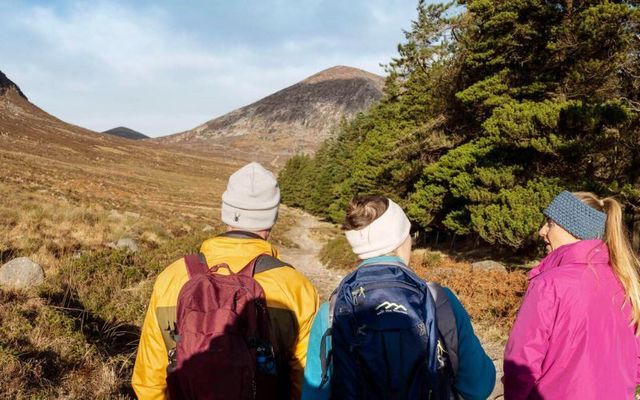
As one of Ireland's most scenic regions, the Mourne Mountains in Co. Down is the perfect location for hikers, walkers, and adventurers.
Whether you're a high climber or just looking for a stroll in idyllic surroundings, the ring of twelve mountains will have a route for you.
Rising up to above 2,000ft (600m) above sea level, the range is home to Northern Ireland’s highest mountain peak, Slieve Donard. The more famous summits, such as Donard, Slieve Bearnagh, or Slieve Binnian offer a hike that the experienced among us will enjoy.
Those who don't fancy working up too much of a sweat can take it easy along the banks of the River Shinma in Tollymore Forest Park or take a ramble around the fascinating volcanic landscape of the Ring of Gullion in Co. Armagh.
- The top natural wonders of Ireland
The Ring of Guillion itself is named an Area of Outstanding Natural Beauty, within which can be found the Kilnasaggart Inscribed Stone (one of Ireland’s earliest Christian monuments) and nearby Moyry Castle
History buffs will enjoy the prehistoric and early-Christian sights among the Ring of Guillion but for nature lovers, the walking trails in Castlewellan Forest Park and Bunkers Hill, home to some of the oldest and rarest existing trees in the British Isles, are a definite treat.
The 4.5 minute film ‘Beyond The Wall’ was created by Ryan Simpson, an amateur photographer/videographer and an architecture student at Queen’s University, Belfast, and the 29 individual clips were recorded between July and December 2015.
The title refers to the 22-mile-long Mourne Wall which traverses 15 different summits and is one of the best-known examples of an Irish dry-stone wall. Taking 18 years to complete, the wall is bound by gravity even as it traverses up the slopes of Slieve Donard.
Such is the beauty of this mountainous area it is said to have inspired C.S. Lewis’ magical world of Narnia. Belfast-born Lewis grew up with the mountains as his playground and is believed to have used memories of his childhood wanderings there when creating the world of "The Lion, the Witch, and the Wardrobe."
“I have seen landscapes (in the Mourne Mountains) which, under a particular light, made me feel that at any moment a giant might raise his head over the next ridge,” wrote Lewis.
It's easy to see what Lewis was getting at in a recently created time-lapse video of the mountains, which captures the beauty of the region as the seasons change.

Are you planning a vacation in Ireland? Looking for advice or want to share some great memories? Join our Irish travel Facebook group.
The mountain range has inspired more than C.S. Lewis, however. Irish songwriter Percy French penned a song in tribute entitled "Mountains of Mourne," which has since been sung by the likes of Celtic Thunder, Don McLean, and The Fureys. The song highlights the beauty of the area in contrast to the more artificial beauty that exists in larger cities such as London as an Irish immigrant in England compares the English fashion to his own homeland.
One of the song's most famous lines says "where the Mountains of Mourne sweep down to the sea" and the mountains more than live up to this as an adventurer's paradise just waiting to be discovered.
Hiking and walking are not the only activities for adventurers either. Royal County Down, one of the best golf clubs in the world, is just a short distance away; you can go sea kayaking or wet bouldering at the rock slides and plunge pools at Bloody Bridge; or visit any of the towns in the area, such as Newry or Rostrevor, each rich in their own history.
Sign up to IrishCentral's newsletter to stay up-to-date with everything Irish!
*Originally published in 2016. Updated in 2023.
Sources : Discover Ireland , Tourism Ireland.
Related: Ireland's Travel Secrets

Ireland's most unique raffle, WIN a new McHale Fusion 4 Plus Baler or €75,000 cash

GIVEAWAY: It's back! Tell us what makes Ireland special and win a trip to the Emerald Isle

The intersection of Saint Patrick and paganism in Ireland

WIN a trip to Ireland: There is still time to make your Irish dreams come true
WWII ship where five brave Sullivan brothers died discovered on St. Patrick's Day
TUNE IN: St. Patrick’s Day Parade LIVE from Dublin today!
US leprechauns versus Irish fairies - a St. Patrick’s Day death match
NYC Saint Patrick's Day Parade announces line of march ahead of March 16
St Patrick's Festival is here! Your guide to the Dublin City celebrations
Sober St. Patrick’s Day to “reclaim the day” today in NYC
“Walking in the footsteps” of your Irish ancestors
- International edition
- Australia edition
- Europe edition

Game of Thrones backdrop in Northern Ireland becomes Unesco geopark
The beauty of the Mourne mountains has led to an award that local artisans hope will also benefit sustainable tourism
I t is said the Mourne mountains of Northern Ireland were “born of fire and shaped by ice”, moulded from 400 million years of geological history into a landscape of dark peaks, drowned glacial lakes and lush green farmland, patchworked by stone walls.
Now, that jaw-dropping beauty, as well as sustainable tourism projects and 25 years of peace, is being celebrated. Unesco has named the Mourne Gullion Strangford region in the south-east corner of the country as the UK’s newest Global Geopark in tribute to its geological past and culturally rich present.
The geopark includes three areas of natural beauty: the Ring of Gullion, the Mourne mountains with the 850-metre peak of Slieve Donard, and wildlife-rich Strangford Lough, the UK’s largest coastal lough.
Between Dublin and Belfast, this area feels about as far as you can get from a city. Verdant hilltops, known as “drumlins”, sweep down to the ocean, interspersed with the occasional unsightly cluster of pebbledash bungalows along winding country roads. Inland, the countryside is crowned by the forbidding granite peaks of the Mournes, while lowland forests and the jagged coastline were perfectly cast as dramatic backdrops in Game of Thrones .
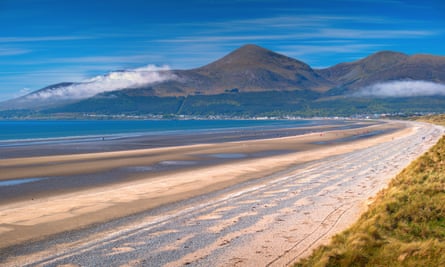
Mourne granite has been used to shape this landscape since Neolithic times, from building the Mourne Wall’s 22 miles, which meanders along 15 different mountains in the region, to being shipped off to New York to form buildings. At Green Holiday Cottages, near Newcastle, I meet Mark Hanna, who runs dry-stone walling workshops from an old flax mill he has renovated. As we practise the (surprisingly mindful) art of stacking stone on stone and “coggle and skim the skelfs and spalls” one by one, which he calls “early Irish Lego”, he teaches me the lyrical vocabulary of this 5,000-year-old artform born of hard necessity.
Mark was born and bred in the local fishing town of Kilkeel. “The lore is that this area was its own little land – they say Saint Patrick never made it this far! This was once an isolated country community where people grew flax or were subsistence farmers, tending to vegetables and owning a cow if they were lucky,” he says.
What does the new geopark status mean for the 180,000 people who live in the area? “Some local farmers are afraid that the label means more restrictions, but I think we take for granted how beautiful our back yard is – it needs protecting,” Mark adds.
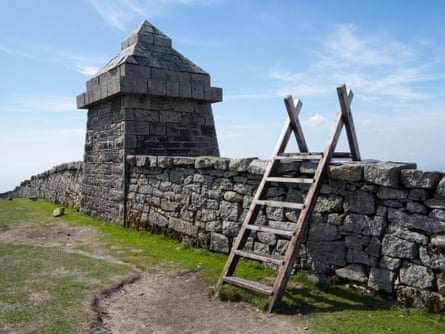
Part of getting – and keeping – Unesco Global Geopark status involves championing sustainable and local tourism experiences like Mark’s dry-stone walling course. This is an area that spills over with makers and creatives, from the smallest distillery in Ireland to woodturners, storytellers, Celtic harpists, farmhouse bread makers, foragers and hiking guides all sharing their expertise with visitors.
Pádraig Carragher is one such creative, a man on a mission to rewild eight hectares (20 acres) at the foot of the Ring of Gullion. Where once there was farmland ravaged by the potato famine is now Bluebell Lane Glamping , wooden pods in a grove of young trees that he runs alongside his woodworking shop – where he makes bowls and pendants from native Irish timber. It’s an idyllic, fairytale glade, graced on one side by a necklace of the rising hills of the Ring of Gullion, and so peaceful it’s hard to picture the tumult this part of the country has known: the village of Crossmaglen, a notoriously violent zone in what was known as “bandit country” during the Troubles, is 10 minutes away.
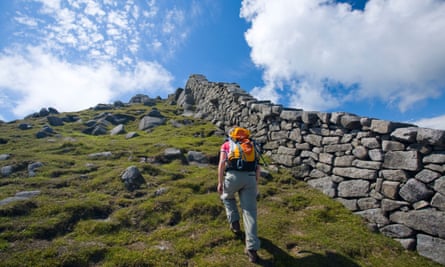
As we walk through the trees, Pádraig explains that encouraging international travellers is still a slow process. “There’s little international tourism here – it’s the coloured history of south Armagh. I see getting visitors to come here as a marathon, not a sprint,” he says. The 23,000 native saplings he’s planted across his land show as surely as his words that he’s in this for the long haul.
On a hike to the summit of Slieve Donard the next day, the visitors Pádraig has been waiting for come thick and fast – cheery hikers of all ages are trekking along the well-cared-for path, which winds through pine forest before emerging on to a mountain saddle with views along the Mourne Wall and across to the Isle of Man, Wales and Scotland on the clearest days. I meet an 82-year-old local man striding to the top who tells me that last year he climbed to this mountain’s peak no less than 60 times. He gives me advice that’s as fitting for the future of tourism in this corner of Northern Ireland as it is for my tired legs: “Sure – you just have to put one foot in front of the other.”
Stay at Bluebell Lane Glamping , camping from £30 , glamping pods from £90 and cottage from £135 a night. Stay at Green Holiday Cottages from £280 a night , minimum two nights, dry-stone walling experiences £50pp
- Northern Ireland holidays
- Walking holidays
- Camping holidays
- United Kingdom holidays
- Game of Thrones
Most viewed

IMAGES
VIDEO
COMMENTS
Mourne Mountains & Ring of Gullion, at the heart of the Mourne Gullion Strangford Geopark. Start planning for your next giant adventure.. Such is the beauty and history of Mourne Mountains & Ring of Gullion that it has inspired pagan chiefs and patron saints, writers, inventors, engineers and visitors from all corners of the world for millennia.
Driving the stunning Mourne Coastal Route gives you some sense of the epic size of these mountains - Northern Ireland's highest - but the best way to see the sights is on foot or by bike. Cyclists should try the Mourne Mountains Cycle Loop, or if you prefer hiking, the variety of terrain on the Mournes will keep even the keenest walker happy.
4. The Mourne Wall. One of the first things you'll notice in the Mournes is the presence of a dry stone wall crossing a bunch of the mountains. Measuring 22 miles in length, the Mourne Wall passes over 15 summits and was completed in 1922. It's also pretty useful when hiking and plenty of the trails follow it!
1. Slieve Donard (via Glen River) Photos via Shutterstock. The mightiest Mourne of them all is Slieve Donard which reaches a gaudy height of 850m (2789ft), making it the tallest mountain in Northern Ireland. We recommend the trail to the summit that goes via the Glen River, and make sure to pack a pair of sturdy walking boots and a decent ...
Let the Mourne Mountains inspire you. The mountains that inspired C.S. Lewis' Narnia chronicles, Game of Thrones® filmmakers, poets and songwriters will not fail to inspire you too. Go trekking or hiking, take the legendary Six Peak Challenge, a walking tour or a thrilling bike ride. Maybe you'd prefer to drive a golf ball or microlight ...
The Mourne Mountains are in Co. Down, Northern Ireland in the Province of Ulster. The range can be found about 30 miles south of Belfast or 60 miles north of Dublin. The easiest way to reach the Mourne Mountains is to self-drive by car. There are no direct buses from Belfast, however, you can reach the town of New Castle by coach bus with one ...
The Mournes have been voted one of Ireland's favourite walking destinations and it's easy to see why. The network of paths and tracks that cross over this mountain range are not all for the faint-hearted, but the views of the valleys, lakes, rivers and reservoirs make it well worth the climb. We care for 526 hectares of the Mournes, which ...
Climb the Regal Mountains of Mourne . Step outside and experience the magnificence of the Mourne Mountains. Discover the many peaks and hills, the fallen valleys, and the sensational views. Slieve Donard is the highest Mountain in Northern Ireland. Hike on a clear day and you can see the Isle of Man, Scotland, Donegal, Wales, and even Wicklow.
There are 12 peaks in total, but the seven highest peaks are the most famous - Slieve Donard, Commedagh, Binnian, Bearnagh, Lamagan, Meelbeg, and Meelmore. Built between 1904 and 1922, the Mourne Wall wasn't just a random construction. It served to delineate the water catchment area for the Silent Valley Reservoir.
The Mourne Mountains are a granite mountain range in County Down in the south-east of Northern Ireland. It includes the highest mountains in Northern Ireland and the province of Ulster. The highest of these is Slieve Donard at 850 metres (2,790 ft). The Mournes is an area of outstanding natural beauty and has been proposed as the first national ...
Driving the stunning Mourne Coastal Route gives you some sense of the epic size of these mountains - Northern Ireland's highest - but the best way to see the sights is on foot or by bike. Cyclists should try the Mourne Mountains Cycle Loop, or if you prefer hiking, the variety of terrain on the Mournes will keep even the keenest walker happy.
The Mourne Mountains (/ m ɔːr n / MORN; Irish: Beanna Boirche), also called the Mournes or Mountains of Mourne, are a granite mountain range in County Down in the south-east of Northern Ireland. They include the highest mountains in Northern Ireland, the highest of which is Slieve Donard at 850 m (2,790 ft). The Mournes are designated an Area of Outstanding Natural Beauty and it has been ...
The Mournes. The Mourne Mountains are a mountain range that includes Slieve Donard, the highest mountain in Northern Ireland. The twelve Mournes in the AONB are Slieve Donard, Slieve Binnian, Slieve Commedagh, Slieve Beg, Slievelamagan, Ben Crom, Slievenaglogh, Slieve Muck, Slieve Meelbeg, Slieve Meelmore, Slieve Loughshannagh, and Slieve ...
It is so easy to get to and around Visit Mourne which is famous for its natural beauty, spectacular landscapes, charming villages and towns and the warm welcome from locals. With good roads, great public transport and a range of discount passes, we do our best to help you get to as many of our most popular attractions and picturesque landscapes ...
While a popular tourist destination today, the Mourne Mountains is an ancient area thought to date back a whopping 56 million years and formed during the Caledonian Orogeny, the same geological period that created the world famous Giant's Causeway, which is located around 99 miles from the Mournes.
The Mourne Mountains have plenty on offer Explore some of the best places to Eat & sleep in Ireland's Playground. Northern Ireland's top Staycation destination Featured. McCoooeys. Café located in Newry City Centre. ... Enjoy the Mournes is your 'Community Travel & Tourism Hub'. One of the ways we support our community is by utilising the ...
Mourne Mountains, Co Down Tourism Ireland. As one of Ireland's most scenic regions, the Mourne Mountains in Co. Down is the perfect location for hikers, walkers, and adventurers. Whether you're a ...
Tours and Tour Guides. The Mourne Mountains & Ring of Gullion has an abundance of fantastic family attractions, outdoor activities, superb local produce to be enjoyed at welcoming restaurants and pubs, indulgent spas, and great shopping experiences. Its absorbing heritage and history include the enthralling St Patrick's Story and mountains ...
The beauty of the Mourne mountains has led to an award that local artisans hope will also benefit sustainable tourism Sian Lewis Thu 25 May 2023 02.00 EDT Last modified on Tue 30 May 2023 10.49 EDT
The Mourne Mountains are located in County Down in Northern Ireland, about 30 miles south of Belfast and 60 miles north of Dublin. The Mourne Wall. The Mourne Wall took 20 years to complete and is approximately 30km in length (1.5metres high). The Mourne Wall crosses fifteen summits and was built as a catchment for the Silent Valley and Ben ...
Visit Mourne, Newcastle, United Kingdom. 20K likes. For those who love the Mourne Mountains & Ring of Gullion and Strangford Lough & Lecale